For many Europeans and Americans Africa is the most interesting continent in the world. It is also a little daunting as we hear so many stories in the media about war, violence and Ebola. In the search of the ‘perfect travel destination’ in Africa many tourists and travelers find Tanzania. The beautiful country is safe to travel in – the more than one hundred twenty different tribes live peacefully together. Even during the past election or since British handed our country to us, we haven’t seen any much disturbance. This is one of the reasons to choose to travel to Tanzania. But there are many more.
First. Tanzania is a land of contrasts. From the Snow-capped of Mt. Kilimanjaro to the endless plains of the Serengeti, from the sun-kissed islands of the Zanzibar Archipelago to the gentle shores of Lake Victoria.
Second. It was here, on the dusty floor of Olduvai Gorge (30 km from Ngorongoro Crater) that early man left his first footprints.
Third. It was also here, on the palm-fringed Zanzibar, that Swahili traders welcomed Arabian ships (dhows) and trading boats from across the Indian Ocean.
Tanzania climate is predominately tropical. Coastal areas are usually hot and humid, but on the beaches a sea breeze cools the air considerably. The average day temperature is 30 degree centigrade (86 deg. Fahrenheit).
Tanzania has two rainy seasons. The long rains season from late March to June and the short rains from November to January. The hottest time of the year is from December to March, before the long rains begin. The coolest months are June, July, and August, when the weather is often overcast. In high altitude areas such as Kilimanjaro and the Ngorongoro highlands the temperatures can fall below freezing.
The capital city of Tanzania is Dodoma, which is a rather unknown and not especially interesting town for tourists. The commercial capital is the better known Dar es Salaam, which means “Port of peace” in Arabic.
Kiswahili is what foreigners often calls Swahili, but actually Swahili means ‘cost’ in Kiswahili. ‘Ki’ means ‘language’ and Kiswahili therefore is ‘the language of the costal people’. But use English as well as second official language.
Arrival at KILIMANJARO AIRPORT (KIA).
All the way from your country, your destination is KIA. You will be picked up from the airport KIA by our assigned representative and driving to chosen hotel in Arusha or Moshi. The journey to Arusha or Moshi takes 45 minutes.
Arusha / Moshi
At hotel / lodge
• Lunch & dinner and Breakfast
• Drinking water (Other drinks not included).
It is fairly easy to enter Tanzania. All you need is:
• A valid passport
• A visa to enter the country and three months single-entry tourist visa are available at Tanzania embassies in your country, price subject to nationality. It is also possible to buy a visa at the arrival at the Kilimanjaro International Airport.
Departure tax from Tanzania and Zanzibar is included in the price of your ticket, whether flying on domestic or international flights.
The Tanzania Shilling (Tsh or TZS). Some travelers use US dollars. We find it easier though, to use the local currency.
Banks and ‘Bureau de Change’ are available at airports and in all major towns. Banking hours are from Monday to Friday 8.30am to 3.00 pm, Saturday 9.30 am to 1.00 pm, closed on Sunday.
We advise these credit cards
Visa, MasterCard, Access.
And remember: It is safer to bring a combination of more cards, for instance a Visa card and a MasterCard, because if you don’t you will risk ending up somewhere with an ATM that doesn’t take your card.
Local time is GMT+3
Electric current: 220 volts 50 Hz
Tanzania is a safe country to travel in, Tanzanians are warm-hearted and generous people and are eager to help visitors get the most out of their stay. Tanzania is a politically stable, multi-democratic country.
As in all countries, a little common sense goes a long way and reasonable precautions should still be taken, such as locking valuables in the hotel safe and not walking alone at night. Remember, where ever you go in the World, it is good to take these precautions!
Kilimanjaro, with its three volcanic cones of Kibo, Mawenzi, and Shira is an inactive stratovolcano in north-eastern Tanzania rising 4,600m from its base and is additionally the highest peak in Africa at 5,895m. While the volcano appears to be dormant on the inside, events on top of the mountain draw global attention. Its three summits of Shira, Kibo and Mawenzi are all of very recent origin. Much as the volcano stands alone, it is a part of an east-west belt of volcanoes stretching over Northern Tanzania.
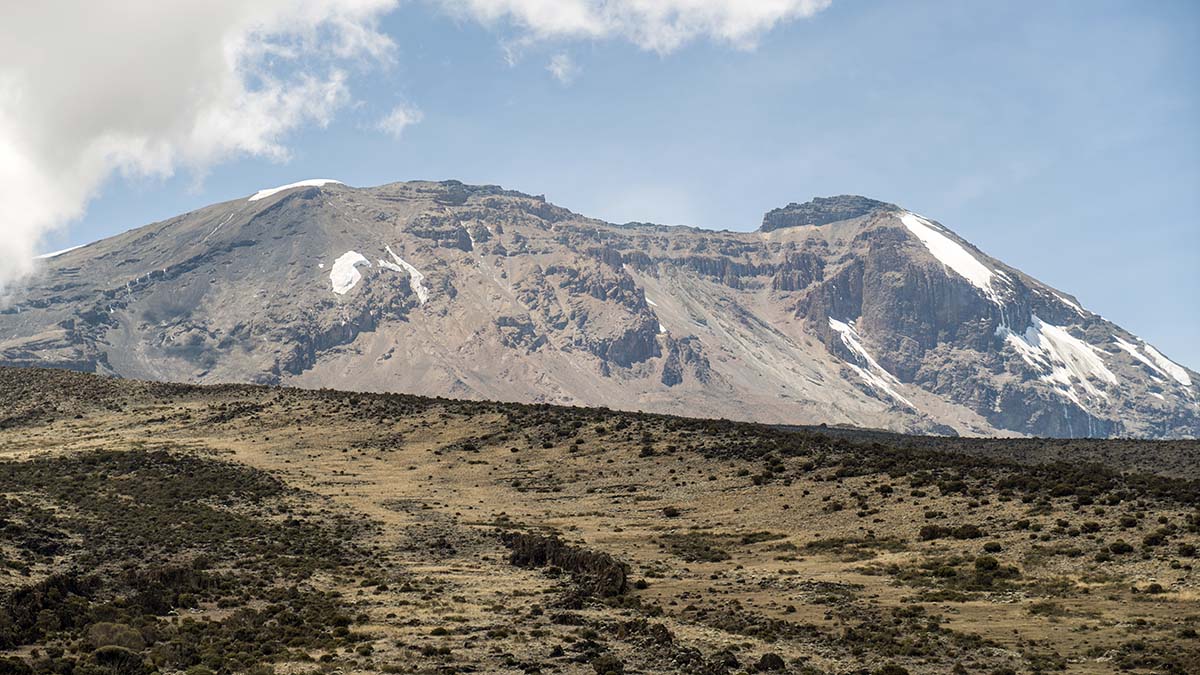
Mount Kilimanjaro is in the shape of a mountainous volcano; it is formed by material being thrown up by the volcano vent, which then piles around the vent in the shape of a cone. Mount Kilimanjaro is made up of tephra, i.e. it has a cinder cone. They are made up of blobs of congealed lava and particles. When the mountain erupted millions of years ago, the gas-charged lava would be blown violently into the air, then breaking into smaller fragments which would solidify and fall as cinders. This left Mount Kilimanjaro with a bowlshaped crater. It is not uncommon for a stratovolcano such as Mount Kilimanjaro to have experienced explosive eruptions. The lava from the mountain is viscous so it cools down before it spreads very far. The lava’s viscosity also helps explain why Mount Kilimanjaro has relatively small crater formations. The rock on the mountain is felsic and thus has high levels of silica, especially tephratic silicate.
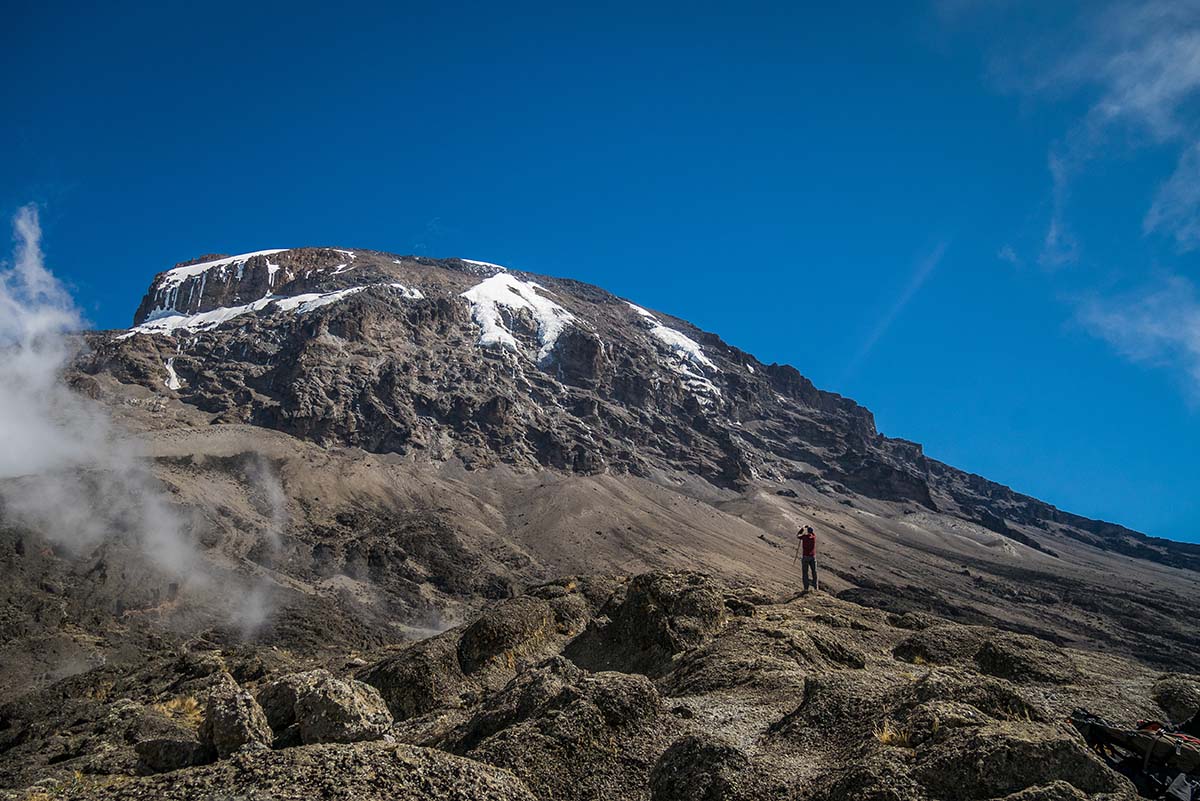
Mount Kilimanjaro is in the shape of a mountainous volcano; it is formed by material being thrown up by the volcano vent, which then piles around the vent in the shape of a cone. Mount Kilimanjaro is made up of tephra, i.e. it has a cinder cone. They are made up of blobs of congealed lava and particles. While it is inactive, Kilimanjaro has fumaroles that emit gas in the crater on the main summit of Kibo. Several collapses and landslides have occurred on Kibo in the past, one creating the area known as the Western Breach. Scientists concluded in 2003 that molten magma is just 400m below the summit crater. The volcano is the highest in Africa and covers an area of 388,500 ha. Although the volcano stands alone, it is a part of an east-west belt of volcanoes stretching over Northern Tanzania. It has three main concentric cones to the southeast in the mountain, but also has smaller parasitic cones. Also known as a satellite cone, the main vent is blocked by cooled solidified lava, and the lava is then forced out through the sides of a volcano under immense pressure. To the west side of the mountain is the peak Shira (3,962 m or 12,999 ft), of which only the southern and western rims remain. The most recent summit is Kibo (5,891.8 m of 19,330 ft) which was last active during the Pleistocene. There are still even fumaroles. Even though there haven’t been eruptions for millions of years, there are openings near Kibo in the Earth’s crust which emits steam and gases.
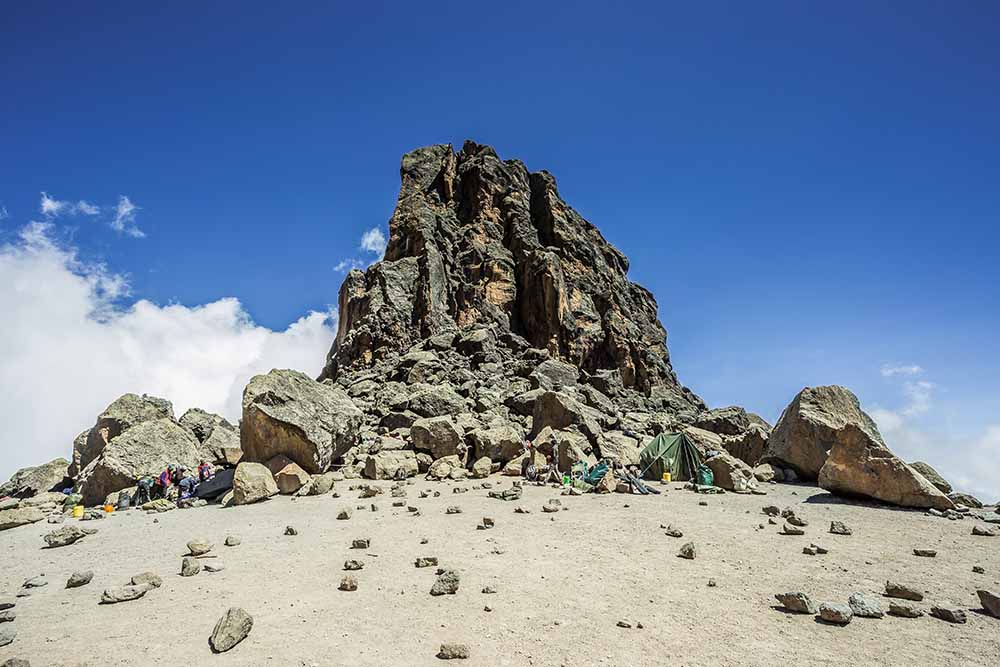
Kilimanjaro has a large variety of forest types over an altitudinal range of 3,000 m containing over 1,200 vascular plant species. And as a result, the mountain has unique vegetation for instance the water holding cabbage in the tussock grassland and other plants like this all adapted to living in alpine conditions. Montane Ocotea forests occur on the wet southern slope. Cassipourea and Juniperus forests grow on the dry northern slope. Subalpine Erica forests at 4,100 m represent the highest elevation cloud forests in Africa. However, forest relicts in the deepest valleys of the cultivated lower areas suggest that a rich forest flora inhabited Mt Kilimanjaro in the past, with restricted-range species otherwise only known from the Eastern Arc Mountains. There is a low degree of endemism on Kilimanjaro a result from destruction of lower altitude forest. The highest point on the mountain is the southern rim of the outer crater. Moreover, between Kibo and Mawenzi is the Saddle, in which it contains high altitude tundra. This type of vegetation forms at high levels of altitude because tree growth is hindered by low temperatures and short growing seasons. There is a wide range of vegetation despite being at high altitude such as dwarf shrubs, grasses, mosses and lichens.
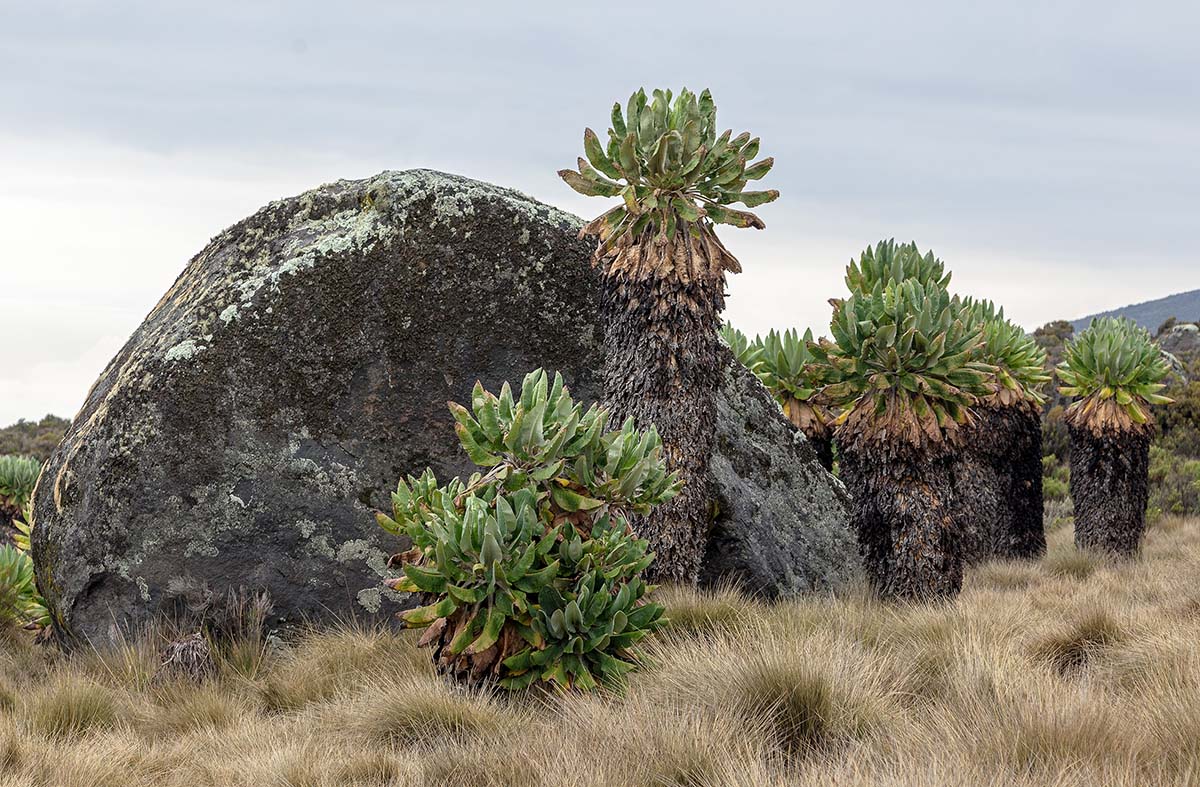
Preparation is half the trip, we say! To succeed we need to bring the right stuff to the peak – and only that
If you are in doubt, please feel free to ask, but we recommend that you read the following before going with us.
If you find it difficult to bring all the stuff, please feel free to contact us. We might be able to rent it to you.
1. Sunhat 5$
2. Sunglasses, 10$.
3. Sunscreen (high factor 35-40 essential) you must buy
4. Head torch 15$, Spare batteries must buy.
5. Thermal hat 10$
6. Balaclava 5$
7. Bandanna 5$
8. Thermal top and bottom at least three pairs each 8$ per each
9. Fleece – two pairs 10$ per item
10. Lightweight trousers two pairs or more (No jeans) 15$ per each
11. Gloves (Inner gloves and outer shell) 5$ per each
12. Rain trousers and rain jackets 15$ per each
13. Summer wear (T-shirts and shorts) 5$
14. Sleeping bag 20$ and Sleeping bag liner 7$
15. Water bottles – at least two but, Camel Bags system is very essential 5$ per each
16. Hiking boots 20$
17. Socks – at least 6 pairs 5$
18. Medication (your own first) must buy.
19. Day pack 30$
20. Soft bag or Rucksack 5$
21. Small towels must buy.
22. Gaiters 10$
23. Poncho 15$
24. Walking sticks 10$ per pair.
1. Rain gear (jacket and trousers)
2. All of your valuables (passport, money etc.)
3. Medical kit
4. Power-bars
5. Water bottles loaded with water
6. Walking poles
7. Toilet paper and plastic bags for packing used paper to the next camp
8. Camera, accessories, cards, charger
9. Sweets
10. Anything which you may think will be very useful to you like MP3-player and iPods as well as diary or reading materials
1. Antiseptic cream and plasters for small cuts and grazers
2. Bandages
3. Compeed for blisters
4. Anti-malaria
5. Ibuprofen/Paracetamol/Asprin
6. Re-hydrating powders
7. Lip salve or chapstick or Vaseline
8. Lozenges
9. Any current medication you are on
10. Diamox
11. Waterproof bag etc.
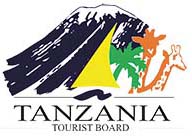



© Copyright 2024 Get Climb and Safari. All rights reserved. Design by TNT Factory
Talk to us